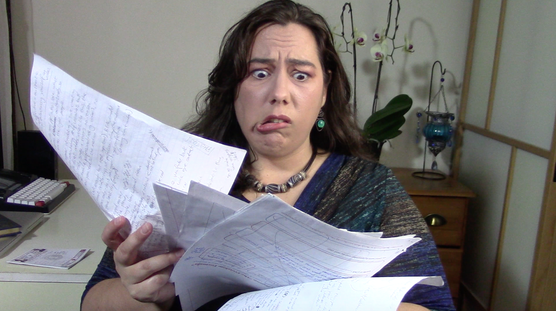The Inspired Speaker Academy
Articles
How to deal with NOTES...8/2/2022 Most speakers, at least when they’re starting out, will prepare for a talk as follows: 1. Spend most of their preparation time writing and rewriting the script 2. Spend the rest of their preparation time creating slides 3. Read through the script at the last minute in a frantic attempt to memorize it. 4. Print out the entire talk and take it up on stage with them 𝗔𝘁 𝘁𝗵𝗶𝘀 𝗽𝗼𝗶𝗻𝘁, 𝘁𝗵𝗲 𝘀𝗽𝗲𝗮𝗸𝗲𝗿 𝗶𝘀 𝗳𝗮𝗰𝗲𝗱 𝘄𝗶𝘁𝗵 𝗮 𝗰𝗵𝗼𝗶𝗰𝗲. They can: a) Read the entire talk, not looking up for more than a glance or two for fear of losing their place in their notes. b) Experiment with going “off-script” and run the risk of getting lost and flustered when they forget what comes next. I can promise one thing in either scenario - 𝘁𝗵𝗲𝘆’𝗿𝗲 𝗻𝗼𝘁 𝗴𝗶𝘃𝗶𝗻𝗴 𝗮𝗻 𝗲𝗻𝗴𝗮𝗴𝗶𝗻𝗴 𝘁𝗮𝗹𝗸! There are a number of problems with the process I have outlined above. The main being that 𝗺𝗼𝘀𝘁 𝘀𝗽𝗲𝗮𝗸𝗲𝗿𝘀 𝘁𝗵𝗶𝗻𝗸 𝘁𝗵𝗲 𝗯𝗲𝘀𝘁 𝘄𝗮𝘆 𝘁𝗼 𝗰𝗿𝗲𝗮𝘁𝗲 𝗮 𝘁𝗮𝗹𝗸 𝗶𝘀 𝘁𝗼 𝘄𝗿𝗶𝘁𝗲 𝗮 𝘀𝗰𝗿𝗶𝗽𝘁. This is actually untrue and there is an alternative process that is MUCH faster and less painful, but I don’t have time to go into that here. So for now, let’s assume the speaker is going about things in the more traditional way - 𝘁𝗵𝗲𝘆 𝗵𝗮𝘃𝗲 𝘄𝗿𝗶𝘁𝘁𝗲𝗻 𝗮 𝘀𝗰𝗿𝗶𝗽𝘁 𝗮𝗻𝗱 𝗻𝗲𝗲𝗱 𝘁𝗼 𝘂𝘀𝗲 𝗻𝗼𝘁𝗲𝘀 𝘁𝗼 𝘀𝗽𝗲𝗮𝗸. #1 The problem with writing out your entire talk is that it’s 𝘁𝗼𝗼 𝗱𝗲𝗻𝘀𝗲. You need to be able to glance down at your notes and 𝗶𝗺𝗺𝗲𝗱𝗶𝗮𝘁𝗲𝗹𝘆 know where in the page you are. 𝗧𝗵𝗮𝘁 𝗺𝗲𝗮𝗻𝘀 𝗻𝗼 𝗽𝗮𝗿𝗮𝗴𝗿𝗮𝗽𝗵𝘀 𝗮𝗻𝗱 𝗻𝗼 𝗳𝘂𝗹𝗹 𝘀𝗲𝗻𝘁𝗲𝗻𝗰𝗲𝘀. How do you fix this? I suggest creating speaker notes that look more like 𝘁𝗵𝗲 𝗱𝗿𝗮𝗳𝘁 𝗼𝘂𝘁𝗹𝗶𝗻𝗲 we were taught to use plan essays at school. So if I’ve written out, say, a 6 line paragraph in my script, 𝗜 𝗺𝗶𝗴𝗵𝘁 𝗿𝗲𝗽𝗹𝗮𝗰𝗲 𝘁𝗵𝗮𝘁 𝘄𝗶𝘁𝗵 𝗮 𝘁𝗼𝗽𝗶𝗰 𝗮𝗻𝗱 𝘀𝗼𝗺𝗲 𝗯𝘂𝗹𝗹𝗲𝘁 𝗽𝗼𝗶𝗻𝘁𝘀 𝗹𝗶𝗸𝗲 𝘀𝗼… Too Dense -need to know your place -use essay structure bullets 𝗦𝗲𝗲 𝘄𝗵𝗮𝘁 𝗜 𝗷𝘂𝘀𝘁 𝗱𝗶𝗱 𝘁𝗵𝗲𝗿𝗲? Providing I have a passing familiarity with my subject matter (I should if I wrote it) those bullet points will be enough to jog my memory. #2 I would also recommend 𝗺𝗮𝗸𝗲 𝘁𝗵𝗲 𝗳𝗼𝗻𝘁 𝘀𝗶𝘇𝗲 𝗯𝗶𝗴 (I like 14 or 16 so I can step away from the podium) #3 𝗗𝗼𝘂𝗯𝗹𝗲 𝘀𝗽𝗮𝗰𝗲 𝗲𝘃𝗲𝗿𝘆𝘁𝗵𝗶𝗻𝗴. Be strategic with your spacing! An advantage of this “outline” approach is that you get 𝗹𝗼𝘁𝘀 𝗼𝗳 𝘄𝗵𝗶𝘁𝗲 𝘀𝗽𝗮𝗰𝗲, so when you look down at your notes it’s a 𝗿𝗲𝗹𝗮𝘅𝗶𝗻𝗴 𝗯𝗿𝗮𝗶𝗻 𝗲𝘅𝗽𝗲𝗿𝗶𝗲𝗻𝗰𝗲. Take a moment to 𝗰𝗼𝗻𝘀𝗶𝗱𝗲𝗿 𝘁𝗵𝗲 𝗱𝗶𝗳𝗳𝗲𝗿𝗲𝗻𝗰𝗲 𝗶𝗻 𝘆𝗼𝘂𝗿 𝗲𝗺𝗼𝘁𝗶𝗼𝗻𝗮𝗹 𝘀𝗲𝗹𝗳 when confronted with a page of cramped text with maybe some scribbles in the margin, compared to looking at a mostly blank page with a few words spaced out on it. If you’re looking at your notes, you’re likely a little flustered already, 𝘀𝗼 𝘄𝗵𝘆 𝗻𝗼𝘁 𝗺𝗮𝗸𝗲 𝘁𝗵𝗲 𝗽𝗿𝗼𝗰𝗲𝘀𝘀 𝗼𝗳 𝘀𝘁𝗲𝗮𝗹𝗶𝗻𝗴 𝗮 𝗴𝗹𝗮𝗻𝗰𝗲 𝗮 𝗽𝗹𝗲𝗮𝘀𝗮𝗻𝘁 𝗮𝗻𝗱 𝗰𝗮𝗹𝗺𝗶𝗻𝗴 𝗼𝗻𝗲? Your notes are there to keep you safe, not to stress you out. #4 No matter how long your talk is - 𝗹𝗶𝗺𝗶𝘁 𝘆𝗼𝘂𝗿 𝗻𝗼𝘁𝗲𝘀 𝘁𝗼 𝟮 𝗽𝗮𝗴𝗲𝘀, 𝘀𝗶𝗻𝗴𝗹𝗲 𝘀𝗶𝗱𝗲𝗱. This way you can place them, secured, in an open binder. You don’t have to touch them and 𝘁𝗵𝗲𝘆 𝗵𝗮𝘃𝗲 𝗻𝗼 𝗰𝗵𝗮𝗻𝗰𝗲 𝗼𝗳 𝗯𝗹𝗼𝘄𝗶𝗻𝗴 𝗮𝘄𝗮𝘆 or getting knocked to the floor and out of order. #5 𝗜𝗳 𝘆𝗼𝘂’𝗿𝗲 𝘀𝗽𝗲𝗮𝗸𝗶𝗻𝗴 𝗼𝗻𝗹𝗶𝗻𝗲, the exact same rules apply except that instead of printed pages, you have a double page document open on your desktop. This should be positioned right at the top of your screen, as close to the lens as you can get. 𝗪𝗵𝗲𝗻 𝗼𝗻 𝗰𝗮𝗺𝗲𝗿𝗮, 𝘆𝗼𝘂 𝗱𝗼𝗻'𝘁 𝘄𝗮𝗻𝘁 𝘁𝗼 𝗵𝗮𝘃𝗲 𝘁𝗼 𝗺𝗼𝘃𝗲 𝘆𝗼𝘂𝗿 𝗵𝗲𝗮𝗱 𝘁𝗼 𝗹𝗼𝗼𝗸 𝗮𝘁 𝘆𝗼𝘂𝗿 𝗻𝗼𝘁𝗲𝘀. In an ideal world I’d be done with notes all together. I personally use them as little as possible, but there are definitely times when they are necessary and so 𝘄𝗵𝗲𝗻 𝘆𝗼𝘂 𝗱𝗼 𝘂𝘀𝗲 𝘁𝗵𝗲𝗺, 𝗽𝗹𝗲𝗮𝘀𝗲 𝘂𝘀𝗲 𝘁𝗵𝗲𝗺 𝘄𝗲𝗹𝗹. I hope these five tips were useful - 𝗽𝗹𝗲𝗮𝘀𝗲 𝗱𝗼 𝗹𝗲𝘁 𝗺𝗲 𝗸𝗻𝗼𝘄 𝗶𝗳 𝘆𝗼𝘂 𝗰𝗵𝗼𝗼𝘀𝗲 𝘁𝗼 𝘂𝘀𝗲 𝘁𝗵𝗲𝗺 𝗮𝘁 𝘆𝗼𝘂𝗿 𝗻𝗲𝘅𝘁 𝘀𝗽𝗲𝗮𝗸𝗶𝗻𝗴 𝗼𝗽𝗽𝗼𝗿𝘁𝘂𝗻𝗶𝘁𝘆 - I’d love to hear how it goes! XOXO
Danielle Benzon Need help speaking? Book a free Vocal Needs Assessment https://calendly.com/daniellebenzon/free-vocal-needs-assessment
0 Comments
Your comment will be posted after it is approved.
Leave a Reply.Join us at the next Speaker's Masterclass Open House EventArchives
July 2024
You might enjoy my personal blog... |
Proudly powered by Weebly


